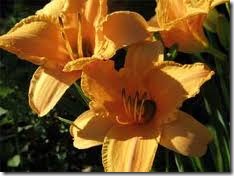Daylilies are a popular flowering perennial that are found in many areas of the Eastern United States. They are known for being a tough and resilient species, easily adapting to any environment. The State of Florida considers them a cosmopolitan plant, meaning that they are found growing in a variety of conditions throughout the state. However, this doesn’t mean that they aren’t susceptible to salt damage, which can result from poor soil conditions, winter street salts or ocean sprays.
Salinity
-
Salt dissolves in water in the soil and the sodium and chloride ions separate. When this occurs, the sodium ions in the salt replace the other nutrients in the soil that plants need such as potassium, nitrogen and calcium. In addition, salts absorb the water that would be taken up by the roots, causing dehydration and stress to the plant. The roots absorb the chloride ions and take them to the leaves where they accumulate and interfere with the production of chlorophyll and photosynthesis.
Features
-
Damage to plants from high levels of salt usually appears as burns on the tips of leaves or leaf margins. There may be irregular foliage with small, shriveled leaves and buds. Sometimes the leaves are blue or whitish in appearance, or the plant may wilt even thought it there is adequate water. Symptoms of salt damage from salt spray will be more severe on the side of the plant facing the street or ocean.
Soils
-
Assess the soil in your planting site. Test kits are available that will determine the soil’s pH level. In low spots with heavy, compacted soil, water cannot drain soluble salts from the soil. Daylilies prefer a well-drained, slightly acidic, sandy loam. Use 3 to 4 inches of organic matter such as sphagnum peat moss, compost or well-rotted manure. Mulching is beneficial because it helps the plants retain moisture, reduces weeds and moderates the soil temperature.
Treatment
-
Saline damaged or over-fertilized plants should be flushed thoroughly with at least 2 inches of water. This will force the salts through the soil and away from the roots of the plant. Remove any old mulch and replace it with 1 inch of clean Canadian peat or humus.
Prevention/Solution
-
Select a planting site well away from the street or sidewalk. Plant daylilies next to a protective fence, building or other plantings of more salt-tolerant trees and plants. Use non-sodium de-icing agents such as calcium chloride or calcium magnesium acetate (CMA), a salt-free agent made from limestone and acetic acid. Plant on slopes where salty water won’t accumulate. Flush salts through the soil by applying 2 inches of water. Repeat if necessary. Fertilize only at the rates recommended by soil tests and on the product labels. Keep plants healthy because weaker plants are more likely to succumb to saline damage.


Deprecated: strpos(): Passing null to parameter #1 ($haystack) of type string is deprecated in /home/agriviek8Qv/agriviet.net/public_html/wp-includes/comment-template.php on line 2522